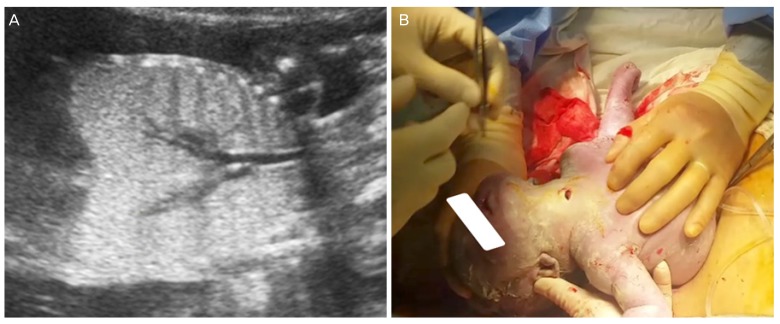1. Hubbard AM, Crombleholme TM, Adzick NS. Prenatal MRI evaluation of giant neck masses in preparation for the fetal EXIT procedure. Am J Perinatol. 1998; 15:253–257. PMID:
9565224.

2. Mychaliska GB, Bealer JF, Graf JL, Rosen MA, Adzick NS, Harrison MR. Operating on placental support: the
ex utero intrapartum treatment procedure. J Pediatr Surg. 1997; 32:227–230. PMID:
9044127.
3. Norris MC, Joseph J, Leighton BL. Anesthesia for perinatal surgery. Am J Perinatol. 1989; 6:39–40. PMID:
2910316.

4. Abraham RJ, Sau A, Maxwell D. A review of the EXIT (
ex utero intrapartum treatment) procedure. J Obstet Gynaecol. 2010; 30:1–5. PMID:
20121493.
5. Park JT, Chang HS, Kwon SY, Um DJ, Choi SJ. Anesthetic management during an ex utero intrapartum treatment (EXIT) procedure of the agnathic fetus: a case report. Korean J Anesthesiol. 2005; 49:724–729.
6. Park HJ, Lee JH, Chung SM, Kim HS. A case of the EXIT (ex utero intrapartum treatment) procedure in congenital fetal cervical immature teratoma. Korean J Otorhinolaryngol-Head Neck Surg. 2008; 51:681–685.
7. Lee H, Ryu JW, Kim DY, Lee GY. Anesthetic management of the
ex utero intrapartum treatment (EXIT) procedure: a case report. Korean J Anesthesiol. 2010; 59:S154–S157. PMID:
21286428.
8. Hwang I, Jung HR, Bae JG. A case of intrauterine lingual cyst with successful delivery assisting ex utero intrapartum treatment procedure. Korean J Perinatol. 2014; 25:22–26.
9. Park H, Jin HS, Kang SH, Park JS. A case of the ex utero intrapartum treatment procedure for fetal giant fourth branchial cleft cyst. Korean J Otorhinolaryngol-Head Neck Surg. 2015; 58:776–780.
10. Mota R, Ramalho C, Monteiro J, Correia-Pinto J, Rodriques M, Guimarães H, et al. Evolving indications for the EXIT procedure: the usefulness of combining ultrasound and fetal MRI. Fetal Diagn Ther. 2007; 22:107–111. PMID:
17135754.

11. Dighe MK, Peterson SE, Dubinsky TJ, Perkins J. Cheng E. EXIT procedure: technique and indications with prenatal imaging parameters for assessment of airway patency. Radiographics. 2011; 31:511–526. PMID:
21415194.
12. Zamora IJ, Ethun CG, Evans LM, Olutoye OO, Ivey RT, Haeri S, et al. Maternal morbidity and reproductive outcomes related to fetal surgery. J Pediatr Surg. 2013; 48:951–955. PMID:
23701766.




